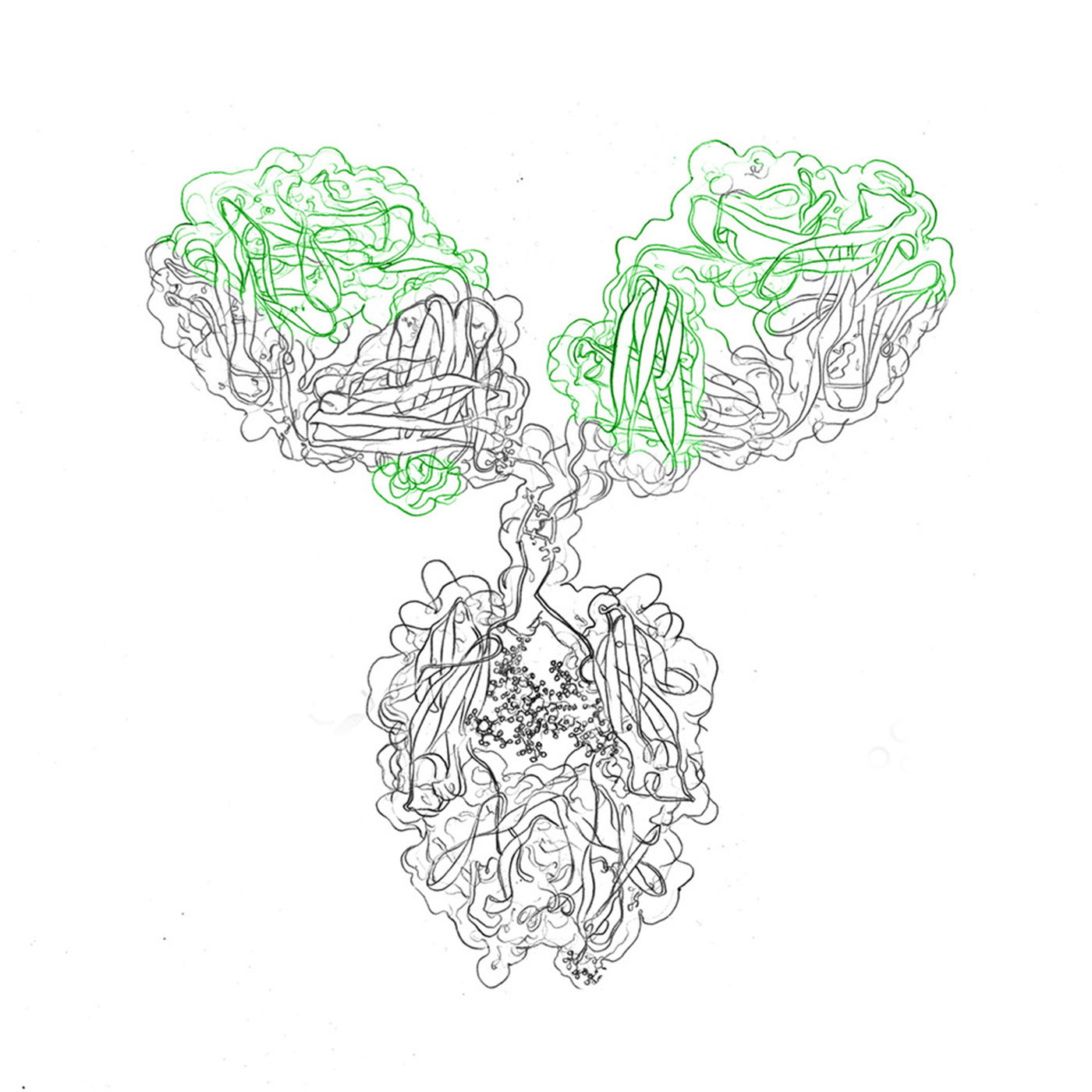Recombinant monoclonal antibody production
We are a leading service provider for recombinant antibody production. Get in contact!
HEK cells, derived from human embryonic kidney tissue, are a cell line with unique characteristics that make them an ideal choice for numerous applications. From their remarkable ability to produce antibodies to their pivotal role in gene therapy research, HEK cells have propelled us into new frontiers of scientific exploration.
But what exactly are HEK cells, and where do they come from? In this article, we will explore the diverse applications, morphology, variants, and even the pros and cons of these extraordinary cells. We will also delve into the intriguing realm of antibody production in HEK 293 cells and compare them with another widely used cell line – CHO cells.
HEK cells (human embryonic kidney cells, often referred to as HEK-293 or HEK293) are a specialized cell type widely used in cell biology research. These cells were derived from human embryonic kidneys and possess unique characteristics that make them valuable in scientific investigations.
HEK cells are adherent epithelial cells, meaning they form monolayer cultures and play a crucial role in tissue development. Their ability to replicate and express genes in laboratory settings makes them highly desirable for various applications.
Subscribe to our Newsletter
Get all the latest updates, and learn about our advancements in antibody production.
Subscribe now
The captivating story of HEK 293 cells traces back to the work of Dr. Alex van der Eb and Dr. Frank Graham in the 1970s. Seeking to develop a human cell line for adenovirus research, they embarked on a series of experiments involving human embryonic kidney cells and human adenovirus type 5.1
The origin of HEK 293 cells can be attributed to the transformation of human embryonic kidney cells by sheared adenovirus 5 DNA. In their pioneering work, Dr. van der Eb and Dr. Graham subjected human embryonic kidney cells to adenoviral infection, causing the cells to undergo transformation and acquire new properties. For several years, it was assumed that the HEK293 cell line derived from fibroblastic, endothelial or epithelial cells. However, there are speculations that they might rather derive from neurons, due to specific messenger RNA segments.1
Interestingly, the name “HEK 293” itself carries historical significance. It represents the 293rd experiment in the series conducted by Dr. van der Eb and Dr. Graham.1
Working with HEK cells involves a meticulous process that encompasses cell culture and transfection techniques. To initiate the production, human embryonic kidney cells are cultivated in a suitable serum-free cell culture environment, typically in an incubator. The cells are provided with essential reagents and nutrients to support their growth and proliferation.
Transfection involves the introduction of specific genetic material, e.g. with viral vectors or plasmids, into the cells. These vectors or plasmids contain the desired genes or genetic elements for expression in the HEK cells.
Various methods can be employed for transfection, including calcium phosphate-mediated transfection, electroporation, or viral transduction using adenoviral vectors. The cells will then start gene expression and protein synthesis, before additional manufacturing steps will follow according to the specific product.

As for their handling, HEK293 cells are considered as a comparatively low-maintenance line in cell biology and can be grown in culture ex vivo. Nevertheless, there are certain recommended cell culture conditions to be met such as a humidified incubator at 37°C supplemented with 5% CO2 as well as a high-glucose media diet to keep the cells alive. Other culturing media such as broad-spectrum antibiotics can help to prevent common bacterial infections.
However, it is important to acknowledge that these are known for causing harm to cells and results. The cell line grows rapidly and can thus be passaged every couple of days. However, if cultured over a certain time, the health of the cells degrades which can affect their reliability in experiments. The commercially available HEK293 transfection reagents and kids, for example through ATCC, add additional convenience to growing this cell line.
HEK cells, derived from human embryonic kidneys, have a wide range of applications across various scientific fields. These versatile cells play a significant role in biotechnology, gene therapy, protein production, virology, and more.
In biotechnology and biopharmaceutical applications, HEK cells are utilized for the production of recombinant proteins, including antibodies and other vital proteins for therapeutic purposes. Gene therapy research benefits from HEK cells, as they aid in receptor signalling, studying gene delivery systems and optimizing gene expression efficiency.
HEK cells also contribute to advancements in protein expression studies, allowing for the production of proteins with high yields and proper folding. In virology, HEK cells serve as an essential tool for studying viral replication, propagation, and the development of antiviral therapies.
Furthermore, HEK cells find applications in genome engineering studies based on CRISPR, as well as other functional assays, enabling researchers to investigate gene function, signaling pathways, and protein interactions. Additionally, HEK293 are used for heterologous expression of cell membrane receptors and ion channels as well as the investigation of signaling pathways of G protein coupled receptors.
Learn more on the different applications of cell culture!
HEK 293 cells, a derivative of human embryonic kidney cells, possess distinctive morphology and exhibit unique characteristics.
HEK 293 cells exhibit an epithelial-like morphology, appearing as adherent cells that form monolayer, adherent cultures. They typically display a flattened, elongated shape with defined cellular boundaries, allowing for easy identification and observation under a microscope. They can be adapted for growth in different media, as well as within suspension culture.
It was long assumed that HEK293 were endothelial, epithelial or fibroblastic cells since those are abundant in embryonic kidneys. However, the presence of specific gene products and mRNA brought up speculations that they might have been neuronal cells. This could have been caused by adding the human adenovirus type 5. Consequently, the cell line should not serve as a representative in vitro model of classic kidney cells.
The HEK293 lineage has several sub variants and derivatives, one of them being HEK 293T. What distinguishes the HEK 293T from its parent cell line is that the derivative contains the SV40 large T antigen. This makes it possible for the transfected plasmids to undergo episomal replication and thus produce a large amount of recombinant protein or retrovirus.
The genome of HEK293 has the characteristics of a human cell line. This also implies that it is suited for producing biotherapeutics since they allow destinctive post-translational modifications. The cells have a very complex karyotype with a chromosome number of 64, four copies of chromosome 17, three X chromosome copies, no Y chromosome-derived sequences, and an integration of 4 kilobases adenovirus type 5 DNA to chromosome 19 of the transformed HEK293 cells. This indicates cytogenetic instability.2
HEK 293 cells are known to be hypotriploid, meaning they possess an abnormal chromosome number. This characteristic is vital to consider when studying gene expression and genomic stability in these cells.
HEK 293 cells have a robust growth potential and proliferate rapidly. They exhibit a high growth rate, allowing for efficient propagation and large-scale production if desired.
The HEK 293 cell derivative HEK 293T expresses the SV40 large T antigen, a viral protein derived from Simian Virus 40. This antigen contributes to their enhanced growth and stability.
HEK cells, with their unique properties and versatility, offer numerous advantages in scientific research. However, it is important to consider the pros and cons of utilizing HEK cells to ensure informed decision-making. Let’s explore the benefits and limitations of HEK cells:
Antibody production using HEK 293 cells has revolutionized biotechnology and therapeutic research. The process begins with introducing plasmids containing antibody genes into HEK 293 cells through transfection. Gene expression leads to antibody production, which can be harvested from the cells or culture medium.
HEK 293 cells have high transfection efficiency and can produce high yields of recombinant antibodies. Their mammalian expression system ensures proper protein folding and post-translational modifications, critical for antibody functionality.
Characterization and sequencing of antibodies are essential to evaluate their specificity and activity. Thorough characterization ensures quality and reliability for diverse applications.
When it comes to antibody expression systems, both HEK (human embryonic kidney) cells and CHO (Chinese hamster ovary) cells have established themselves as reliable platforms. Along with HeLa cells, they belong to the most popular cell types in biotechnology.
Here, we have summarized some major similarities and differences when comparing HEK vs. CHO cells.
We are a leading service provider for recombinant antibody production. Get in contact!

For several decades, researchers have relied on HEK cells due to their unprecedented capabilities. However, there have been major developments in recombinant protein expression and in vitro gene expression, which led to the promotion of CHO cells (Chinese Hamster Ovary cells) as antibody expression platform. This cell line can provide high batch-to-batch consistency as well as the necessary flexibility. Furthermore, CHO cells are advantageous for both small and large scale applications, which is why we at evitria rely on this cell type for our recombinant antibody expression services.
With CHO cells, we are able to rapidly produce recombinant antibodies and proteins, providing partners worldwide with outstanding quality.
HEK cells are used in various scientific fields, including biotechnology, gene therapy, protein expression, and virology. They are valuable for producing recombinant proteins, including antibodies, and for studying cellular processes and gene regulation.
HEK293T cells are derived from HEK293 cells, which are derived from human embryonic kidney cells. HEK293T cells have been genetically modified to express the SV40 large T antigen, enhancing their transfection efficiency and viral packaging capabilities.
The main difference is that HEK 293T cells express the SV40 large T antigen, while HEK 293 cells do not naturally express it. This modification in HEK 293T cells enhances their transfection efficiency and viral packaging capabilities.
No, HEK 293 cells are not cancer cells. They are a type of immortalized cell line derived from human embryonic kidney cells, widely used in research due to their ability to divide and grow indefinitely. They were originally isolated from healthy kidney tissue in 1973 and have been extensively employed for studying various cellular processes and producing proteins in biomedical research.
The karyotype of HEK 293T cells typically consists of a near-diploid chromosome number, which is approximately 46 chromosomes. However, due to their status as an immortalized cell line, they can occasionally exhibit chromosomal abnormalities or variations. It’s important to note that the specific karyotype of HEK 293T cells can vary between different batches or sublines, and genetic changes may accumulate over time due to their extensive use in research.